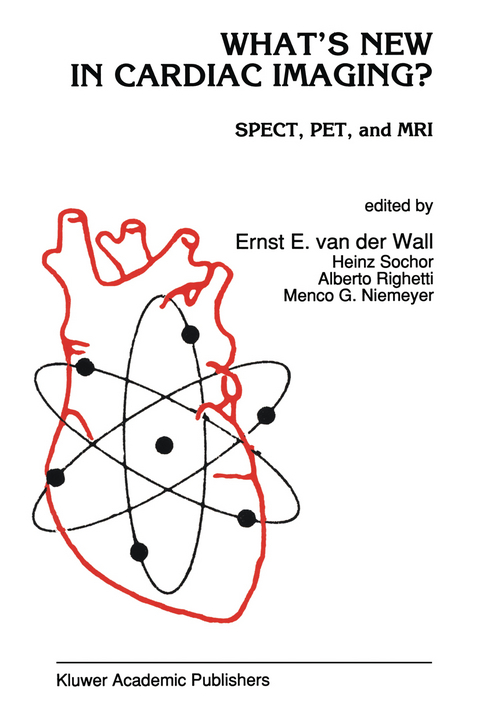
What’s New in Cardiac Imaging?
Springer (Verlag)
978-94-010-5083-8 (ISBN)
In recent years many more advances have been made in cardiovascular nuclear imaging, such as the development of new imaging agents, reevaluation of existing procedures, and new clinical applications. This book describes the most recent developments in nuclear cardiology and also addresses new contrast agents in MRI.
What's New in Cardiac Imaging will assist the clinical cardiologist, the cardiology fellow, the nuclear medicine physician, and the radiologist in understanding the most recent achievements in clinical cardiovascular nuclear imaging.
1. What’s new in cardiac imaging?.- 2. Why new cardiac imaging agents?.- Section one: Perfusion.- 3. The value of measuring myocardial perfusion in coronary artery disease.- Single photon imaging.- 4. Myocardial perfusion imaging with xenon-133.- 5. Myocardial perfusion and krypton-81m.- 6. Myocardial perfusion imaging with technetium-99m isonitriles; attractive thallium substitutes?.- 7. Is there a specific role for technetium-99m SestaMIBI in the assessment of cardiac arrhythmias?.- 8. Technetium-99m complexes of functionalized diphosphines for myocardial perfusion imaging in man.- 9. Myocardial perfusion imaging with technetium-99m teboroxime.- Positron emission tomography.- 10. Clinical applications of rubidium-82 myocardial perfusion imaging.- 11. Nitrogen-13 ammonia perfusion imaging.- 12. Quantification of myocardial perfusion with oxygen-15 water.- 13. Myocardial perfusion imaging with copper-62 labeled Cu-PTSM.- Magnetic resonance imaging.- 14. Application of contrast agents in magnetic resonance imaging: additional value for detection of myocardial ischemia?.- 15. Magnetic resonance imaging using paramagnetic contrast agents in the clinical evaluation of myocardial infarction.- Section two: Metabolism.- 16. Assessment of myocardial metabolism in vivo. a biochemist’ view.- Single photon imaging.- 17. Myocardial metabolic imaging with iodine-123 fatty acids.- Positron emission tomography.- 18. Assessment of myocardial fatty acid metabolism with carbon-11 palmitate.- 19. Myocardial metabolic imaging with fluorine-18 deoxyglucose.- 20. Myocardial metabolic imaging with carbon-11-acetate.- Section three: Infarct-avid imaging.- Single photon imaging.- 21. Infarct-avid imaging: usefulness, problems and limitations.- 22. Myocyte necrosis-avid with radiolabeledantimyosin antibody: experimental and clinical acute myocardial infarction, myocarditis and heart transplant rejection.- 23. Myocardial infarct imaging with cardiac troponin-I antibodies.- Section four: Function.- Single photon imaging, positron emission tomography.- 24. Radionuclide imaging in the evaluation of cardiac function: new developments?.- Single photon imaging.- 25. Krypton-81m equilibrium radionuclide ventriculography for the assessment of right ventricular function.- 26. Simultaneous assessment of myocardial function and perfusion.- Section five: Sympathetic nerve system.- Single photon imaging.- 27. Radiolabeled metaiodobenzylguanidine (1-123 MIBG): value in clinical cardiology?.- 28. Scintigraphic assessment of cardiac innervation using iodine-123 metaiodobenzylguanidine.- 29. Clinical experience with iodine-123 metaiodobenzylguanidine.- Positron emission tomography.- 30. Studies of cardiac receptors by positron emission tomography.- 31. Heart neuronal imaging with carbon-11- and fluorine-18-labeled tracers.- Section six: Leukocytes, platelets, lipoproteins.- Single photon imaging.- 32. Labeling of leukocytes, platelets, and lipoproteins: useful in clinical cardiology?.- 33. Indium-111 leukocyte scintigraphy for detection of valvular abscesses and vegetations.- 34. Detection of cardiac thrombi with indium-111 platelet scintigraphy.- 35. Scintigraphic detection of atherosclerosis with radiolabeled low density lipoprotein.- Section seven: Viability.- Single photon imaging, positron emission tomography, magnetic resonance imaging.- 36. Assessment of myocardial viability with scintigraphic techniques and magnetic resonance imaging: new attainments?.- Positron emission tomography.- 37. Is it worth assessing regional myocardial viability with positron emissiontomography?.- 38. Assessment of tissue viability after myocardial infarction with fluorine-18 deoxyglucose using planar imaging; the alternative approach.- Section eight: Alternative stress imaging.- Single photon imaging, echocardiography, magnetic resonance imaging.- 39. New developments in pharmacological stress imaging.
| Reihe/Serie | Developments in Cardiovascular Medicine ; 133 |
|---|---|
| Zusatzinfo | XX, 550 p. |
| Verlagsort | Dordrecht |
| Sprache | englisch |
| Maße | 160 x 240 mm |
| Themenwelt | Medizinische Fachgebiete ► Innere Medizin ► Kardiologie / Angiologie |
| Medizinische Fachgebiete ► Radiologie / Bildgebende Verfahren ► Radiologie | |
| ISBN-10 | 94-010-5083-X / 940105083X |
| ISBN-13 | 978-94-010-5083-8 / 9789401050838 |
| Zustand | Neuware |
| Haben Sie eine Frage zum Produkt? |
aus dem Bereich


